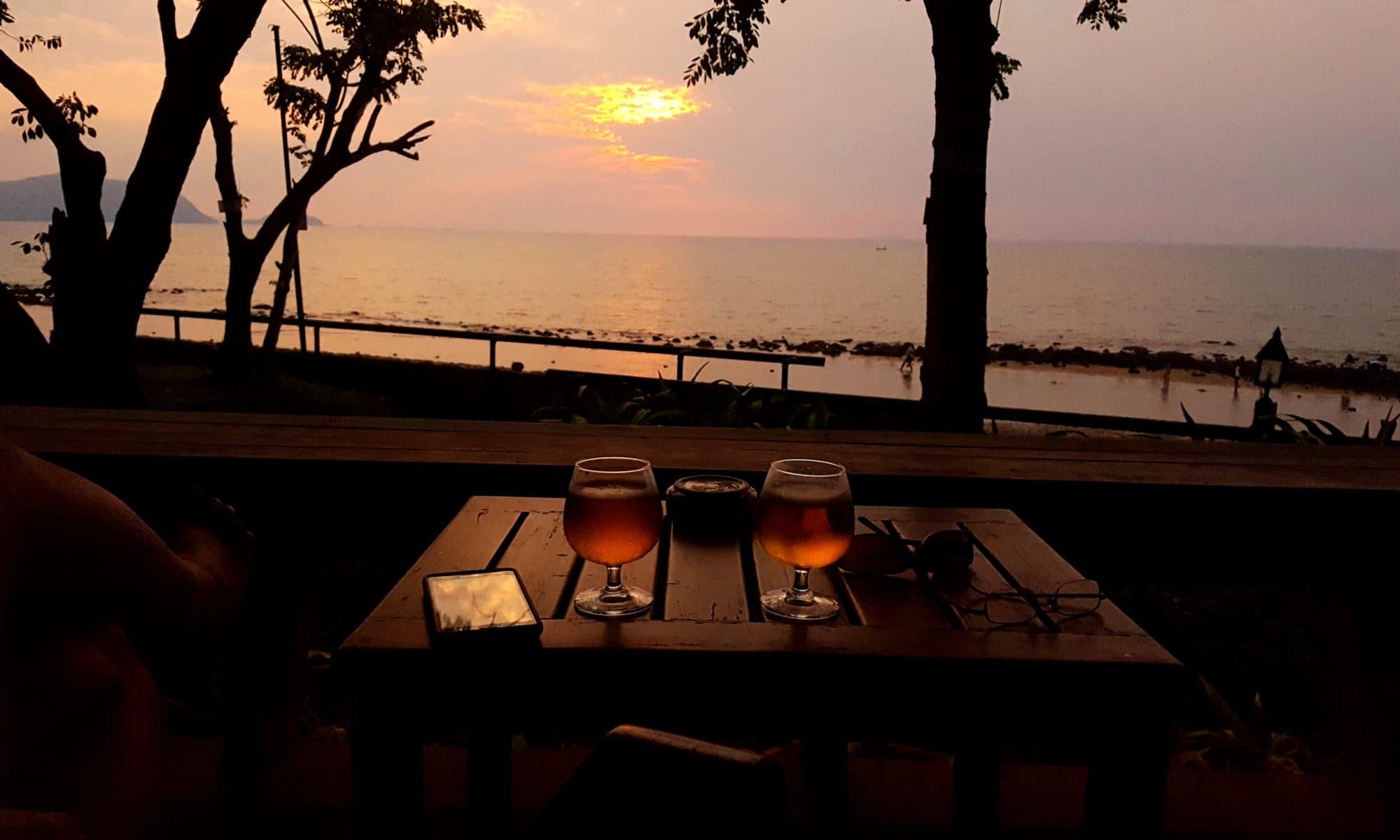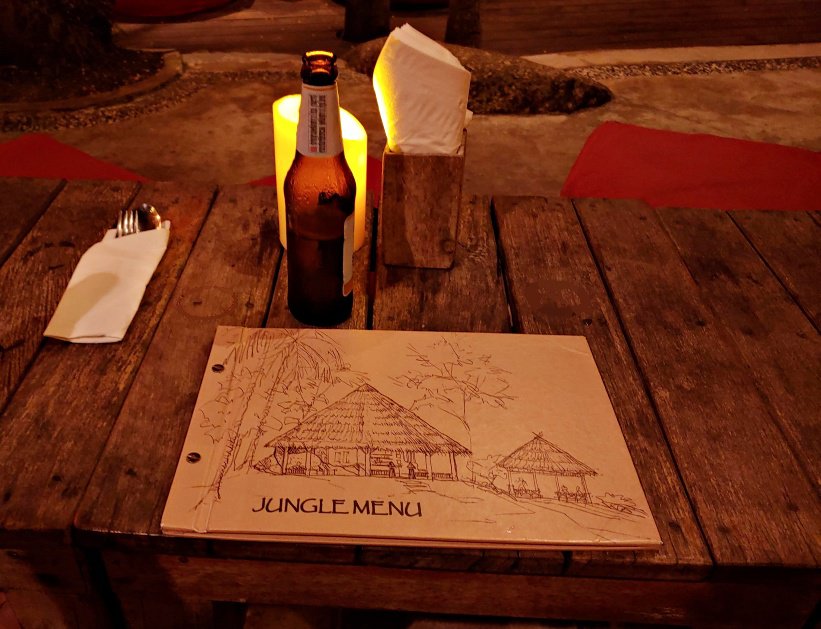
Not to long before our last trip to Thailand, Thanya and I decided to remove all animal products from our diet. In the past we mainly ate chicken, eggs, some seafood and very little to no pork or beef. Milk and butter was only for baking and Cheese was eaten sparingly. Therefore, for us, it was not that difficult of a transition.
But, then we went to Thailand. Admittedly, we were a little worried. So we decided we could go more to the vegetarian side while we were in Thailand.
As non-meat eaters, here is what we learned as a result from our last trek through Thailand.
Is Thailand good for vegetarians & vegans?
Yes….but? The reason I say this is it depends on how much work you want to put into it. How strict of a vegan or a vegetarian are you? What motivates you to be vegetarian or vegan?
As I said above, we were not so strict in Thailand because we didn’t want to work too hard at it. But, that doesn’t mean you can’t enjoy your trip to Thailand as a vegetarian or vegan.
Let’s show you how to do just that.
What does vegetarian mean in Thailand?
For the most part, vegetarian in Thailand basically means you don’t eat chunks of meat or seafood. If you order say…., gaeng keow wan (green curry) no gai (chicken), this does not mean there is no form of meat in the dish. It will most likely contain nam pla (fish sauce) and gapi (shrimp paste).
This is just how it is in Thai food, because fish sauce is Thailand’s salt and shrimp paste is a very common seasoning. You can ask for no fish sauce “in some dishes” in most eateries but shrimp paste is almost unavoidable for curry dishes as it is already in the pre-made curry paste.
That being said, each dish contains a very small amount of these seasonings. Therefore, it might not be a problem for you. But, if this does not work for you, then you will have to work a little harder at sticking with your rules. So, this all depends on how strict or not strict of a vegetarian you are.
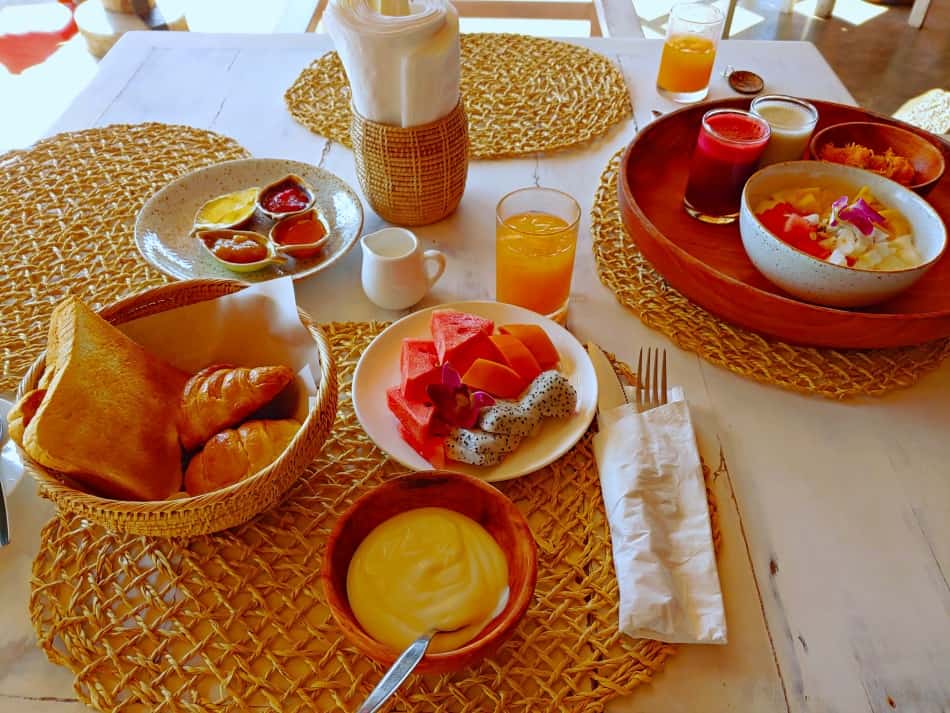
Don’t worry. More help on this as you read on.
What does vegan mean in Thailand?
Vegan is very strict in Thailand (mainly for Monks) because it is based on “not harming any living things”. This means no animal or seafood products and even no garlic, onions, chives, scallions and leeks. Honey, alcohol and tobacco are also excluded from the diet.
This philosophy was originally rooted in ancient Chinese Buddhism, which is why veganism in Thailand can be so strict. Onions, garlic, chives, leeks and scallions are banned in veganism for two reasons.
One is, they are said to lead to “anger” when eaten raw and “passion” when eaten cooked. And number two, onions are said to be unhealthy for your kidneys, garlic for your heart, and chives for your liver.
In most cases, Thailand’s Monks are dependent on their food by donations from people. Monks are expected to eat what they are given because they have little say over what is put into their bowls.
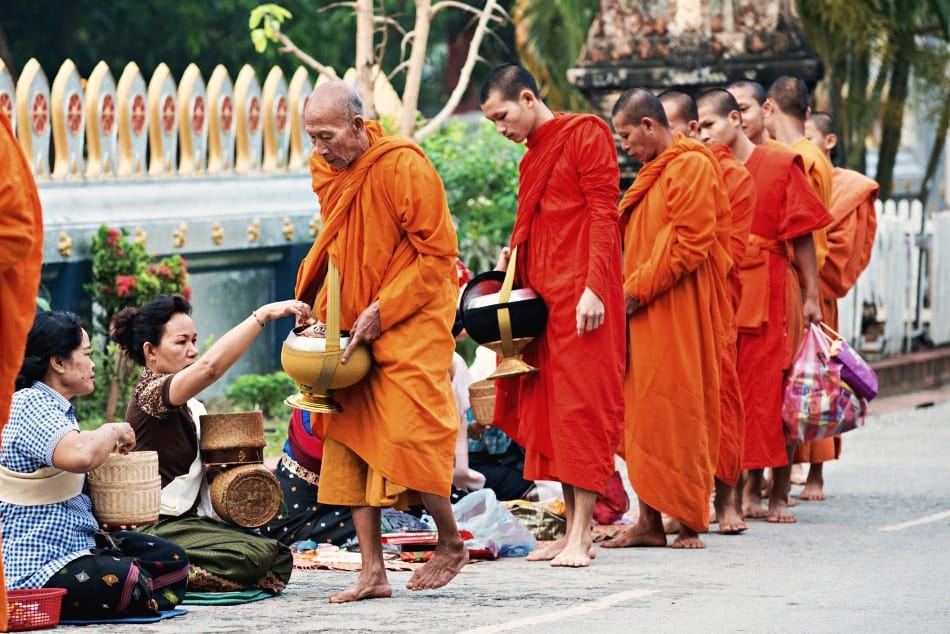
Because of this fact, the general rule is that this is the only time they will stray from veganism. Monks must not have the meat prepared specifically for them and Monks must not see or be involved in the slaughter or preparation of the meat.
Can you eat vegetarian in Thai restaurants?
Thailand’s mid size and large cities have many types of restaurants, serving Thai food, Indian food, Italian food, western style food and western fast food, to name a few. Therefore, you should not have a problem finding some vegetarian dishes on these menus. Especially Indian food, as there are many Indians that are vegetarians.
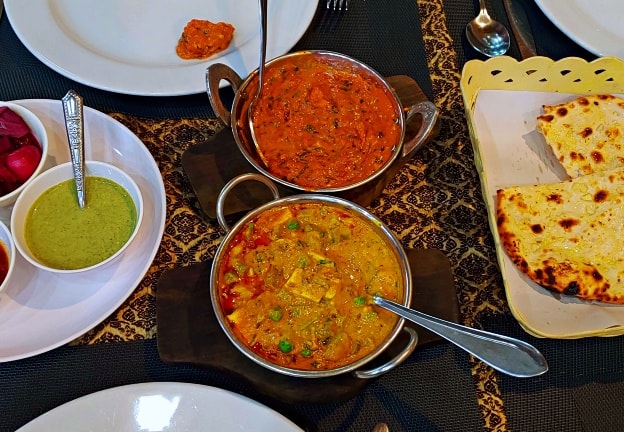
But, as far as Thai food is concerned, you will have a little harder time getting it completely vegetarian. From beef and chicken broth to fish sauce and shrimp paste, you just have to ask the server if it has these ingredients in the dish you are eyeing on the menu.
The first way to do this is to tell your server you are a vegetarian. Don’t worry, most Thai’s in the service industry around the more touristy areas speak some English as their second language. But, as I mentioned before, “vegetarian” is a loose term, so the dish may still have animal products you don’t want.
That brings us to the second way to get your point across. You will then have to tell them each ingredient you can not eat and then see if the kitchen can accommodate your needs. Because most Thai dishes are cooked to order, this might be easier than you think.
Can you eat vegan in Thai restaurants?
Well, pretty much the same applies as eating vegetarian. You will have to work at it with Thai food. But, there is another way to guarantee the menu is vegan. Find a “Jay” restaurant.
Jay restaurants serve Buddhist vegan food in a buffet style that is on the cheap. Look for the signs that look like a red 17 on a yellow background. It is actually the Chinese character for “strict vegetarian” or now more so “vegan” and is accompanied by the word “jay”, also in Chinese.
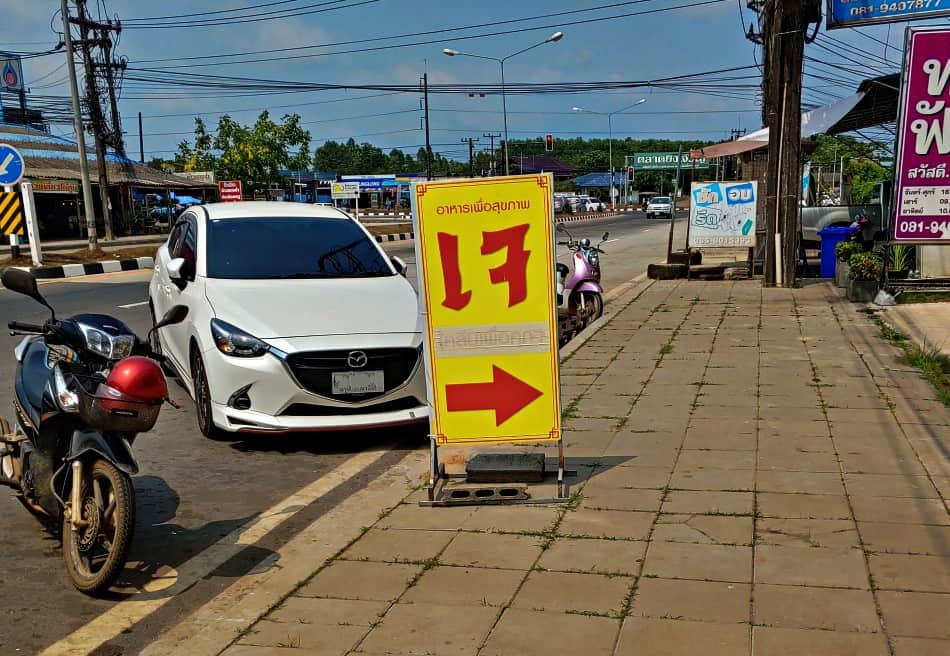
When you visit a Jay restaurant, all the buffet style dishes “5 to 10 of them” are strictly vegan. A typical meal will be a plate of white rice and your choice of one, two or three picks from the buffet. Some jay restaurants will serve noodle soups and other dishes and typically have water, soy milk and homemade juices.
Often, these restaurants will double as small markets and will have mock meats and other vegan food products for sale. This is especially good for those who like to cook and have lodging with a kitchen.
Many supermarket food products in Thailand can be found with the “jay” label. But, more on that later
Most Jay shops open early and close mid afternoon or early evening. Therefore it is advised, when you get a hankering for some vegan fried tofu and noodles, not to expect them open at night. Just sayin’.
Update:
There are some vegan and vegetarian restaurants popping up in Thailand as the demand is becoming stronger. We found a few in Pattaya, Koh Samui and Bangkok, so just google the area you are visiting and see what you can find.
Yes Vegan in South Pattaya is our favorite so far. From burgers to Thai dishes, to wraps to pizza to kombucha drinks and everything in between.
Check out this Nam Tok we had made with mock duck. It was the best!
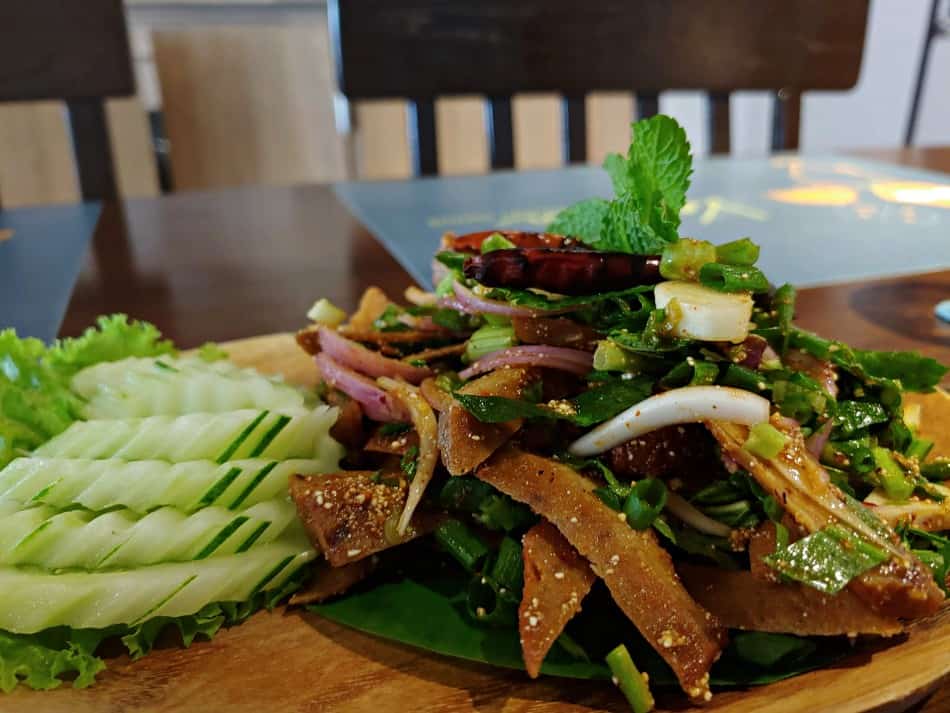
Can you eat Thai street food as a vegetarian/vegan?
For a few reasons, this is going to be more difficult than the traditional Thai restaurants, “and even more so for vegans”.
One reason is, most street food venders cater to local Thai’s and therefore cook accordingly. Thai’s love pork, chicken and seafood and want it in many of their dishes. In fact, in some areas of Bangkok, I had a hard time even getting chicken. Pork seemed to be the main meat at all the little restaurants and street food carts I went to.
Number two is actually the same problem in almost all eateries, (even in most countries). If an eatery is not all vegetarian or vegan, there is a good possibility that there will be cross contamination with animal products.
For instance, it is quite common to use the same fry pans/woks or the same deep fryers to cook meat as they do to fry your tofu and veggies. This will more than likely be the case with street food. Because these vendors usually only have enough room for one or two woks/pans, they will use the same for all foods.
Number three is, you might have to speak a little Thai for these street cooks to understand you. For this reason I have included some Thai words and phrases at the end of this post to help you on your quest for Vegetarian/vegan food.
Buying food to cook and eat at home.
One thing about Thai’s is, they love big open markets and night bazaars. A menagerie of fresh raw fruits and vegetables are jam packed into these markets. Lots of veggies and fruits can be cooked in varying ways or just eaten raw. If you like a lot of raw foods, these can sustain a “raw and or cooked food” vegetarian or vegan without any problems.
Fresh fruit.
Depending on the season, you will have an assortment of fresh fruit to choose from in Thailand. Mangosteen, rambutan, pomelo, rose apple, lychee, bananas and coconut. Custard apple, plum mango, guava, jack-fruit, mango, dragon fruit and pineapple are also available.
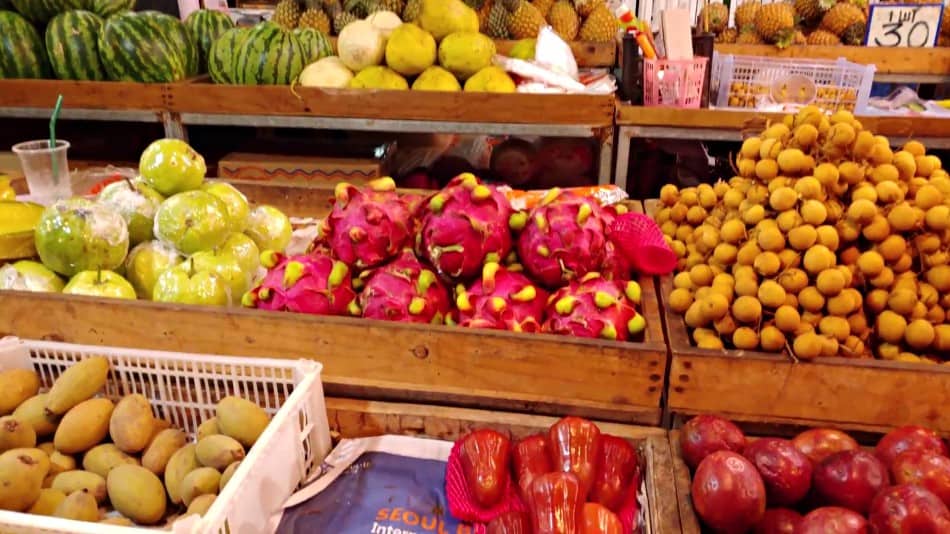
This list can get extensive if we add in all the western types of fruit you will find at most supermarkets and markets. Several apple varieties, oranges, watermelon, grapes, honeydew and cantaloupe are available.
Fresh vegetables, roots and herbs.
On the veggie side, you can’t go wrong at the markets either. There are fresh herbs for cooking like, holy basil, Thai basil, lemon grass, ginger, Thai chili, turmeric root and galanga to name a few. These are a staple in many Thai dishes.
Along with western veggies like carrots, onions, celery and potatoes, you will be overwhelmed with all the other choices in Thai markets. Green curry with Makuea Praow (Thai eggplant) and Tua Fak Yaow (long beans) used in stir-fries and som tum “papaya salad”, the list goes on and on.
If you can think of it, you can find it and make it. From fresh salads to stir-fries to vegetable fried rice and rice noodle soups, you can’t get bored with food in Thailand.
Western style food.
There are some western style food products in the supermarkets to help you on your quest for cooking vegetarian/vegan food. I have written an article on the subject of western food in Thailand ( although not much on the vegetarian/vegan part). It will give you info on where to shop and what to expect.
If you opt for supermarkets or convenience stores, look for the “Jay” logo on products as I stated above. This is the logo for vegan in Thailand so you can’t go wrong.
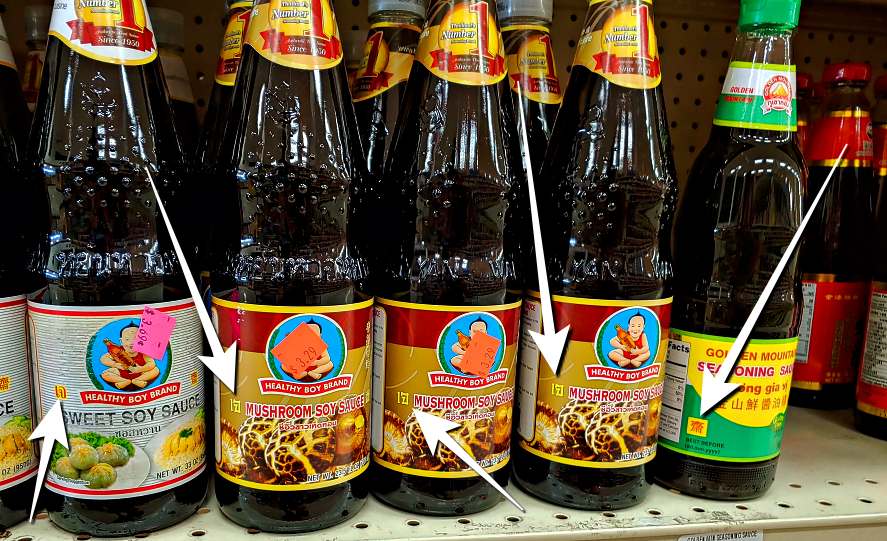
Khantoke dinner and a show in Chiang Mai.
If you are going to visit Chiang Mai, you can’t miss this traditional northern Thai dinner. The menu offers a traditional khantoke dinner, a halal dinner and a vegetarian dinner. Seven kinds of northern Thai dishes are served on a round rattan tray called a “toke”. This will also include rice, clear soup, coffee/tea and fresh fruit to top it off.
Expect to be there for two to two and a half hours eating, drinking and watching the wonderful classical style dances of northern Thailand. The vegetarian food was the best I have ever had to this day. It was just that good!
I also highly recommend this for a dinner night out in Chiang Mai. Take your honey out already!
You don’t want to miss my article “My Top Tips For Three Memorable Days In Chiang Mai, Thailand” and for the link to the Khantoke restaurant we went to.
Vegetarian festivals in Thailand.
If you happen to be in Thailand during Thailand’s Vegetarian festivals (Sept. 28 to Oct. 7 2019), you will be in vegan heaven. The bigger cities like Bangkok, Phuket and Chiang Mai will have large festivals where everything is vegan.
Although the smaller cities might not have large festivals, all of Thailand observes the 9 day Chinese Buddhist Vegetarian holiday. There will be something for every vegetarian/vegan either way you go.
Phuket.
Because of its displays of awe-inspiring religious rituals, Phuket’s vegetarian festival is by far the most well known. Walking on fire and the impaling of body parts are a regular sight at the carnival style festival. If you are faint of heart, you might not want to attend.
A very large amount of fire crackers are used at some points during Phuket’s festival, because they are believed to scare of the spirits. So, if you want to get up close in the thick of things, you should have ear plugs, eye/sunglasses and have something to cover most of your head and body. These firecrackers are not as small as the ones in the USA and the amount used is overwhelming.
Chiang Mai.
If you are in Chiang Mai, the best place to celebrate is at the city’s oldest market, (Warorot). Warorot is located in Chiang Mai’s “Little China Town” just east of the old city off Chang Moi Road. Although the festivities are not as robust as Phuket’s, it is still a must see and do. Oh, and eat. By all means, eat!
Bangkok.
Chinatown’s Yaowarat road is the location of the vegetarian festival in Bangkok. As with Chiang Mai, it is much calmer than the festivities in Phuket. For nine days, all the regular restaurants and street venders revert to the ways of veganism. The usual smells of cooking meat are no longer floating in the air here.
7-11 and Family-mart.
During the 9 day festival, these convenience stores will convert to a “Jay” menu. Yes, that is right. They take all the food items off the shelves and re-stock them with “Jay” labeled products. After the nine days are up, back to the ways of meat.
Thai dishes that are vegetarian/vegan.
Hear is a list of some Thai dishes that can be converted to vegetarian/ vegan in most eateries. Do some food exploring also as there are hundreds of dishes to be found throughout Thailand.
-
Som tam.
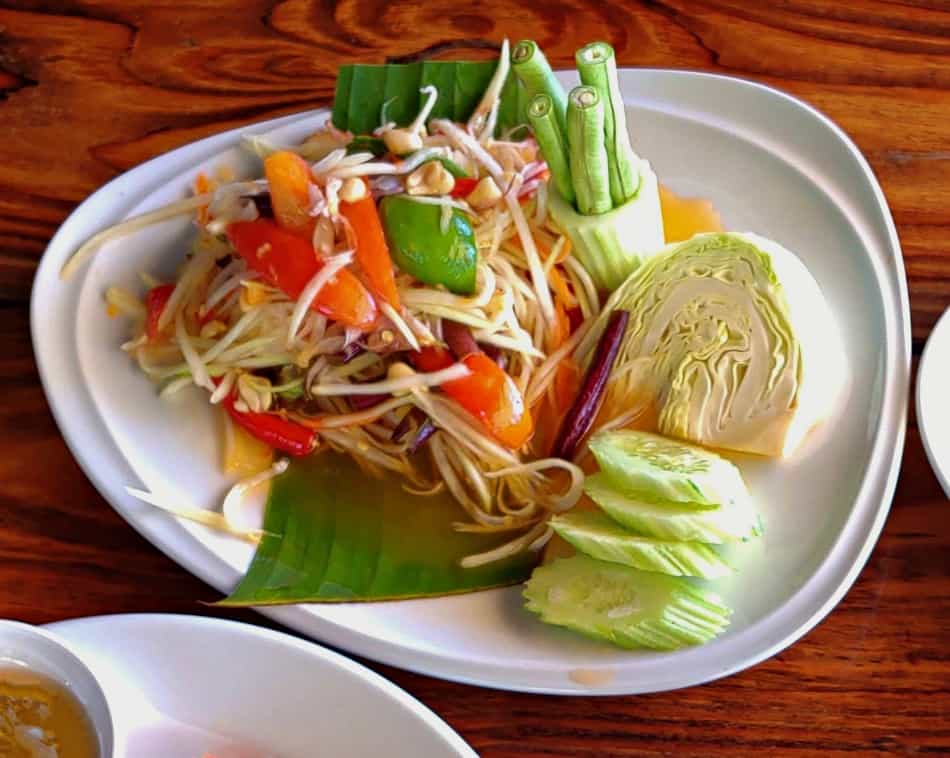
Papaya salad “Som Tam” at Sabeinglae Restaurant on Koh Samui, Thailand. “Papaya salad”. This is one of my favorites and I like it spicy. Som tam will usually have fish sauce, shrimp paste and dried shrimp which can all be eliminated. Salt or soy seasoning can be a replacement for the fish sauce.
-
Pad Thai.
“Thai style stir-fry noodles” will have fish sauce, egg and your choice of meat. Ask for no fish sauce with tofu “vegetarian” or no fish sauce, no egg and add tofu for vegan.
-
Curry dishes.
“Gaaeng” will more than likely have fish sauce, shrimp paste and some might be prepared with cows milk instead of coconut milk. Store bought Thai curry pastes contain these ingredients. Therefore, if the restaurant doesn’t make the paste from scratch, they have no control over this. Therefore, this is one you will probably need to get at a Jay restaurant if you are strict with your diet.
-
Basil stir-fry.
“Pad ga prow”. This dish is usually made with minced beef, pork or chicken but can be made with fried tofu or minced bean curd. It will also contain oyster and fish sauce that can easily be replaced with mushroom sauce and soy sauce. Most Thai stir-fries will have these two sauces in them. Again, one of my favorites and make it spicy.
-
Soups.
“Gaaeng” will contain fish sauce, shrimp paste and sometimes milk like the curry dishes. But, unlike the curry dishes, these will contain beef, chicken or pork stock. Ask if the kitchen has a veggie stock and to leave out the other animal products if they can.
-
Ground beef salad.
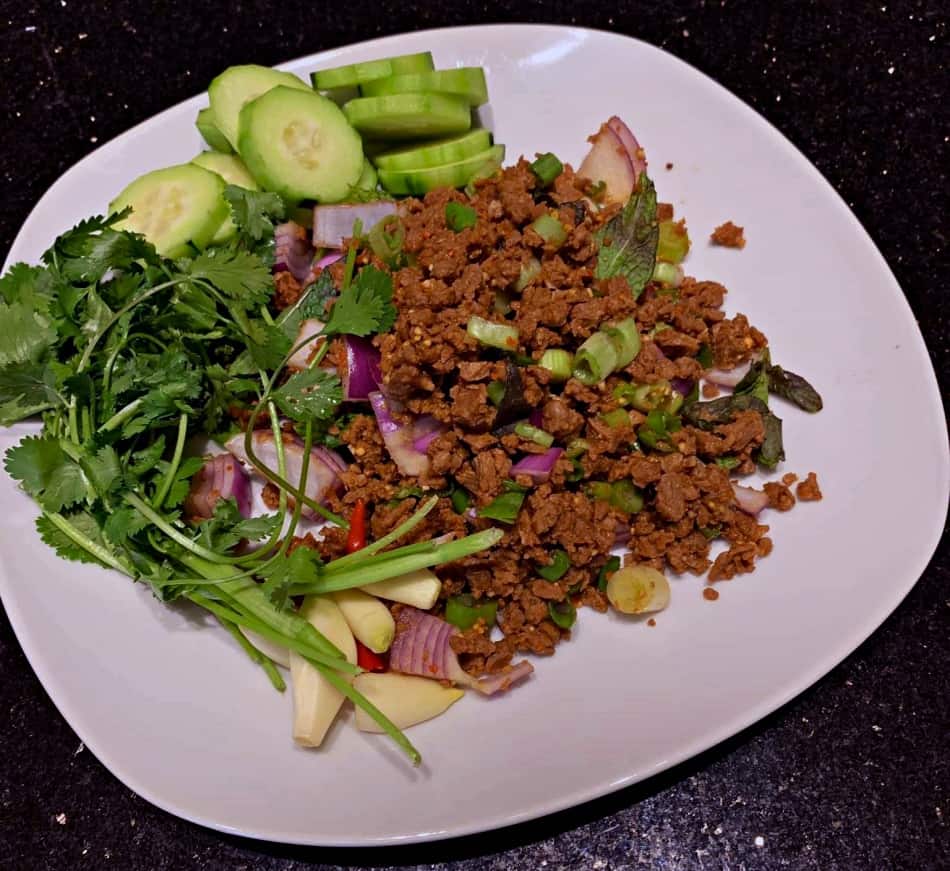
Vegan “laab” Thanya made at home. “Laab nuea” has fish sauce and beef, chicken or pork. Ask if it can be made with minced fried tofu or bean curd and no fish sauce. This dish was brought down from the north of Thailand and is a favorite with most Thai people.
-
Thai mango salad.
“Mamuang” can be ordered without fish sauce and dried shrimp to make this a refreshing vegan dish.
-
Thai desserts.
Most Thai sweets will be fine for vegetarians and vegans. For vegans, ask if they might contain milk or eggs and go from there. Pretty easy on this one.
The key Thai words for vegetarians & vegans.
- Eat vegetarian – “ghin mangsawirat”.
- Eat vegan – ” ghin Jay”.
- No fish sauce – “Mai nam pla”.
- No milk – “Mai nohm”.
- Shrimp paste – “gapi”.
- No seafood – “Mai ahaanthalaeh”. The “h in th” is silent.
- No meat – “Mai neua”.
Conclusion?
With a little work and know-how, eating as a vegetarian/vegan in Thailand shouldn’t be a problem. Try new things. Explore the menus and learn to have fun trying to speak some Thai with the locals. Trust me, Thai’s love it when you try. Just watch them smile and giggle when you get it partly right.
Happy eating vegetarian/vegan in Thailand!
